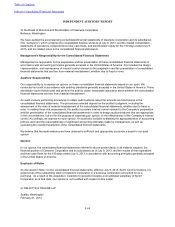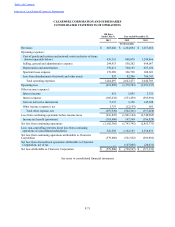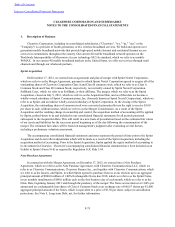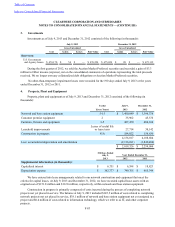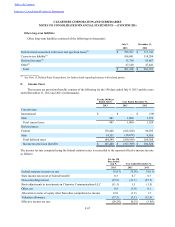Sprint - Nextel 2014 Annual Report Download - page 161
Download and view the complete annual report
Please find page 161 of the 2014 Sprint - Nextel annual report below. You can navigate through the pages in the report by either clicking on the pages listed below, or by using the keyword search tool below to find specific information within the annual report.
Table of Contents
Index to Consolidated Financial Statements
CLEARWIRE CORPORATION AND SUBSIDIARIES
NOTES TO CONSOLIDATED FINANCIAL STATEMENTS —(CONTINUED)
F-78
The three-tier hierarchy for inputs used in measuring fair value, which prioritizes the inputs used in the
methodologies of measuring fair value for assets and liabilities, is as follows:
Level 1: Quoted market prices in active markets for identical assets or liabilities.
Level 2: Inputs other than quoted prices that are observable for the asset or liability such as quoted prices for
similar assets or liabilities in active markets; quoted prices for identical assets or liabilities in less
active markets; or model-derived valuations in which significant inputs are observable or can be
derived principally from, or corroborated by, observable market data.
Level 3: Unobservable inputs that are significant to the fair value measurement and cannot be corroborated
by market data.
If listed prices or quotes are not available, fair value is based upon internally developed or other available
models that primarily use, as inputs, market-based or independently sourced market parameters, including but not
limited to interest rate curves, volatilities, equity prices, and credit curves. We use judgment in determining certain
assumptions that market participants would use in pricing the financial instrument, including assumptions about
discount rates and credit spreads. The degree of management judgment involved in determining fair value is
dependent upon the availability of observable market parameters. For assets or liabilities that trade actively and have
quoted market prices or observable market parameters, there is minimal judgment involved in measuring fair value.
When observable market prices and parameters are not fully available, management judgment is necessary to
estimate fair value. In addition, changes in market conditions may reduce the availability and reliability of quoted
prices or observable data. See Note 11, Fair Value, for further information.
Accounts Receivable — Accounts receivables are stated at amounts due from subscribers and our wholesale
partners net of an allowance for doubtful accounts. See Note 15, Related Party Transactions, for further information
regarding accounts receivable balances with related parties.
Inventory — Inventory primarily consists of customer premise equipment, which we refer to as CPE, and
other accessories sold to retail subscribers and is stated at the lower of cost or net realizable value. Cost is
determined under the average cost method. We record inventory write-downs for obsolete and slow-moving items
based on inventory turnover trends and historical experience.
Property, Plant and Equipment — Property, plant and equipment, excluding construction in progress, is
stated at cost, net of accumulated depreciation. Depreciation is calculated on a straight-line basis over the estimated
useful lives of the assets once the assets are placed in service. Our network construction expenditures are recorded as
construction in progress until the network or other asset is placed in service, at which time the asset is transferred to
the appropriate property, plant and equipment, which we refer to as PP&E, category. We capitalize costs of additions
and improvements, including salaries, benefits and related overhead costs associated with constructing PP&E and
interest costs related to construction. The estimated useful life of PP&E is determined based on historical usage of
identical or similar equipment, with consideration given to technological changes and industry trends that could
impact the network architecture and asset utilization. Leasehold improvements are recorded at cost and amortized
over the lesser of their estimated useful lives or the related lease term, including renewals that are reasonably
assured. Included within Network and base station equipment is equipment recorded under capital leases which is
generally being amortized over the lease term. Maintenance and repairs are expensed as incurred.
PP&E is assessed for impairment whenever events or changes in circumstances indicate that the carrying
amount of an asset may not be recoverable. When such events or circumstances exist, we determine the
recoverability of the asset's carrying value by estimating the expected undiscounted future cash flows that are
directly associated with and that are expected to arise as a direct result of the use and disposal of the asset. If the
expected undiscounted future cash flows are less than the carrying amount of the asset, a loss is recognized for the
difference between the fair value of the asset and its carrying value. For purposes of testing impairment, our long-
lived assets, including PP&E and intangible assets with definite useful lives, and our spectrum license assets are
combined into a single asset group. This represents the lowest level for which there are identifiable cash flows which


